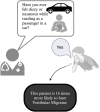Motion sickness whilst reading as a passenger in the car is highly predictive of vestibular migraine
- PMID: 39206287
- PMCID: PMC11349626
- DOI: 10.3389/fneur.2024.1426081
Motion sickness whilst reading as a passenger in the car is highly predictive of vestibular migraine
Abstract
Background: Vestibular Migraine (VM) is a prevalent vestibular disorder, affecting up to 2.7% of the general population. Despite the establishment of diagnostic criteria by the Bárány Society and its inclusion in the International Classification of Headache Disorders, the clinical diagnosis of VM remains challenging due to its complex pathophysiology and symptom overlap with other dizziness disorders. Motion sickness is a core feature of migraine and can be interrogated through simple questionnaires.
Objective: This study aims to identify to what extent motion sensitivity can predict VM compared to other causes of dizziness.
Methods: We conducted a cross-sectional study involving 113 patients from the vestibular neurology clinics at University College London Hospitals. Participants were categorized into VM, Persistent Postural Perceptual Dizziness (PPPD), combined VM and PPPD, and 'other' dizziness etiologies. Data on motion sickness history and dizziness during car travel were collected through structured interviews and analyzed using logistic regression to assess the predictive value of these symptoms for VM.
Results: A substantial portion of patients with VM (91.2%) reported nausea or dizziness when reading as a passenger, a symptom significantly more prevalent than in those with PPPD or other dizziness diagnoses. Logistic regression indicated that VM patients are significantly more likely to experience these symptoms compared to non-VM patients, with an odds ratio suggesting a strong predictive value for this symptom in diagnosing VM.
Conclusion: The findings highlight increased motion sensitivity while reading in a moving vehicle as a promising diagnostic tool for VM, offering a practical aid in clinical settings to distinguish VM from other vestibular disorders.
Keywords: diagnostic biomarkers; dizziness; motion sensitivity; motion sickness; vestibular disorders; vestibular migraine.
Copyright © 2024 Rova, Joffily, Carvalho, Cortese, Koohi and Kaski.
Conflict of interest statement
The authors declare that the research was conducted in the absence of any commercial or financial relationships that could be construed as a potential conflict of interest. The author(s) declared that they were an editorial board member of Frontiers, at the time of submission. This had no impact on the peer review process and the final decision.
Figures


References
-
- Zhang Y, Kong Q, Chen J, Li L, Wang D, Zhou J. International classification of headache disorders 3rd edition beta-based field testing of vestibular migraine in China: demographic, clinical characteristics, audiometric findings and diagnosis statues. Cephalalgia. (2016) 36:240–8. doi: 10.1177/0333102415587704, PMID: - DOI - PubMed
LinkOut - more resources
Full Text Sources

